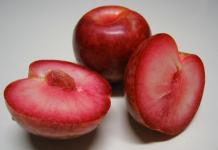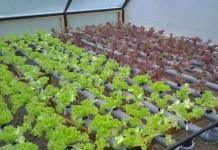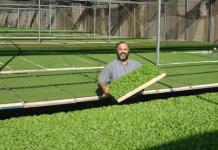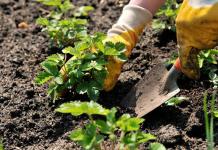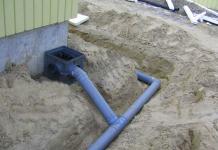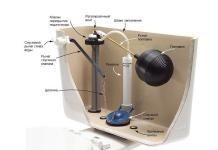Is it possible to earn a million over the summer? You can, and growing greens in a greenhouse and then selling onions, dill, parsley will help you with this... However, in order for the business to take off, you will have to try.
Great business idea
Particular attention should be paid to the greenhouse. You will need this, and not a greenhouse or open ground.

There are several reasons for this:
- It is much more convenient to fertilize the beds.
- The crop growing season is extended to 9 months, and accordingly the harvest will be larger.
- The weather won't stop you from doing business.

If we talk about greens, the greatest demand is for:
- feather bow;
- spinach;
- dill;
- basil;
- salads;
- sorrel;
- radish;
- onion.

All the other greens will not sell well, but if you want to diversify the assortment, you can include them too. The main thing is to know and take proper care. This will allow you to achieve your goal in the shortest possible time.

Project profitability assessment
You can prove that the profitability of an enterprise is high using a simple example. Each summer resident has a plot of land, the area of which ranges from 6 to 20 acres. With a good harvest, you can harvest up to 2 tons of greenery per acre in one season!
The average cost of one kilogram of greens is about 150 rubles. Now do the math for yourself.
Two tons of greenery is about 300 thousand rubles (for one season). And since when growing in a greenhouse you can harvest about 3 crops, it’s quite possible to earn a million.

Greenhouse preparation
The best option for growing greens would be to install a thermos greenhouse. What's good about her?
The double coating of the structure allows you to do without additional heating.
You can begin preparing for planting as early as mid-February. It is first recommended to remove the snow around the greenhouse and lay down black film or roofing felt. Black covering material is also laid inside the room - it attracts the sun well.
As a result, in March it is already possible to sow dill, onions and radishes. The soil will thaw by about 15 cm, this is quite enough.

Growing green onions
There are 3 types of onions:
- sweet;
- spicy;
- semi-sharp.
Which one should you choose? Spicy onions ripen the fastest, but their feather mass is small. Sweet onions have the largest mass of feathers, but they take a very long time to mature. It turns out that semi-sharp varieties will be the best option.
Onions are planted in boxes in February. Then in March they are picked and placed in a greenhouse.
The distance between the bulbs should be 5 cm. After you plant the first batch, you should think about the second. To do this, new seeds are planted in boxes. By the beginning of the first harvest (after 20 days), the seeds will sprout and can be planted.
Before harvesting the onions, the beds should be watered thoroughly. Then wait 6 hours, and the plant is pulled out along with the heads.

Growing dill
The most popular greenery is dill. In view of this, approximately 50% of the harvest should consist of this plant. Varieties must be selected early. Varieties need to be updated every three years.
Before planting, the seeds are soaked but not germinated. Sowing occurs in beds located from north to south. It is necessary to carry out watering and weeding in a timely manner. The distance between dill plantings should be 10 cm.
But before you start growing this or that additional type of greenery, you need to pay attention to demand. Undoubtedly, the variety of assortment will attract customers, but if you grow unclaimed crops, you risk being at a loss.
How to grow greens in a greenhouse (video)
Collection and transportation
- A few hours before harvesting, the beds are watered abundantly with water.
- Then the dill is pulled out, the roots are thoroughly cleaned of soil and dried.
- Next, the greens are placed in special waterproof containers, the leaves should be at the top.
- Placing the product in water with fertilizers, fertilizing and an aspirin tablet will help to store the product longer. In this case, the dill will be fresh for a week.
How to sell your harvest
Greens are often used in restaurants, cafes, and snack bars. It is sold in markets, supermarkets and grocery stores. Retail sales require the provision of special information. At the market, it will be enough to show a certificate stating that you have a household plot.
Greens must be sorted by size. So, a bow with a long feather is supplied separately, and a bow with a short feather, accordingly, goes in a different batch. The cost of the product depends on who purchases the product from you. Old, dried, unsalable greens are removed from the container, it is better not to be greedy, lower the price a little relative to the prices of competitors. Thus, you will be able to sell more, and accordingly, the profit will be greater.

Investments and profit
When starting a business from scratch, the most money will be spent on the greenhouse. For example, a thermos greenhouse costs about twenty-five thousand rubles. You should also consider the cost of purchasing seeds, but you can grow them yourself, in this case there will be no costs.
The area of the greenhouse is 10 square meters. The total profit from one harvest should be 6800 rubles. Several harvests can be harvested per season. The amount of profit will increase to about 32 thousand rubles. The number of greenhouses is not limited, it all depends on the area of your site.
The profitability of the business “Sale of greenhouse greens” is high. Costs are low, payback is quick, demand is constant. In order for people to buy greens from you, you need to monitor the quality of the products and slightly reduce the price relative to competitors.
In order not to lose the material, be sure to save it to your social network VKontakte, Odnoklassniki, Facebook by simply clicking on the button below.
Today we will talk about a business that is not new in itself. Despite this, its profitability is only growing from year to year. We've probably seen grandmothers selling greens at the market more than once. As soon as spring begins to approach, they rush to plant useful herbs that are in demand in cooking on their plots in order to be the first to offer their goods to the buyer. The whole point of a home gardening business is to sell the product as early as possible.. During this period, the entrepreneur's income will be the highest. Although, the sale of herbs is not at all limited to the spring months. Demand for this product exists throughout the year.
- Where is the best place to set up a garden for growing herbs for sale?
- Technology for growing greens for sale
- How much can you earn?
- Step-by-step plan for starting a business
- How much money do you need to start a business?
- How to choose equipment
- What OKVED code must be specified for growing greens for sale?
- What documents are needed to open
- Which tax system to choose for growing greens for sale
- Do I need permission to open?

The most popular for home businesses and in demand among consumers are usually onions, parsley and dill. Recently, our compatriots are increasingly trying the cuisines of other countries of the world. If necessary and stable demand, you can expand the assortment of your crop with leaf lettuces and head crops that have a short growing season. Housewives often buy basil for dishes with meat, and celery is indispensable during winter preparations.
Where is the best place to set up a garden for growing herbs for sale?
To grow greens for sale at home, you need to decide where they will grow. There may be several options:
- Firstly, this is a greenhouse. However, not everyone has it on their plot. To start such a business at home, you will need to build it. Construction of a heated greenhouse is a process that requires capital investment. Today there are many ready-made factory structures that can be installed quickly enough at home and do not require construction knowledge. The cheaper way is to build a site with closed ground from old double-glazed windows. Investments are significantly reduced, but the entrepreneur will need work and considerable ingenuity to make the premises suitable for growing early vegetables.
- Secondly, it is fashionable to adapt any utility room in which it is possible to maintain a constant temperature of at least +20 degrees for growing early greenery at home. Under such conditions, plants are placed in several tiers on special shelves. Early seedlings always need additional lighting, so you need to think about ways to place lamps so that each tray of greens is illuminated evenly.
Technology for growing greens for sale
The next stage in preparing our plantation is soil preparation. It can be bought in special stores. However, if the businessman’s goal is still to earn money, then it is cheaper to prepare it yourself. For growing greenery at home or in a greenhouse, a substrate of ordinary forest soil is suitable. You don’t need to collect all of it, but select the one that is under the layer of leaves. It contains all the useful substances that our plants will need. Already at home, the soil is reseeded and loaded into trays installed at home or in a greenhouse. They can be wooden or plastic. The main thing is that their depth is at least 8-10 cm.

The process of planting seeds itself is not complicated. It is carried out in the same way as in open ground, following the recommendations indicated on the instructions for the seed. But you shouldn’t plant it all at once. To obtain a stable harvest over a long period of time, only 10% of the entire available area is first sown. After a few days, the seeds are planted on the same number of pallets. This scheme works optimally when you have at least 15 sq.m. areas ready for sowing. So growing fresh herbs at home will bring the expected income.
After the plants grow, you need to harvest on time. Particular attention is paid to onions. If you overexpose it, the feather begins to turn yellow and the onion loses its presentation. Parsley and dill are less demanding, although their young leaves emit more fresh aroma. Overexposed stems of greens become rough and tough. Greens are usually packaged immediately after cutting. The less mechanical movements it is exposed to, the better its presentation will be preserved.
How much can you earn?
Business in fresh herbs at home is not only about the ability to grow crops at home. You still need to be able to sell it. If an entrepreneur does his business on his own, he will not have time to stand in the market. It is better to find a wholesale buyer who will pick up the goods in batches at an affordable price. If such a home business has a family format and the owner has assistants, then implementation will be easier. You can set up sales through your own retail outlet.
The peculiarity of business is its seasonality. This is not to say that greens are not in demand in the summer, it’s just that it’s most profitable to sell them in winter and early spring. By the way, during these months a kilogram of herbs usually costs more than meat or fish. So, over the course of a year, 1 kg of dill costs an average of 90 rubles per kilogram. With the onset of cold weather, its price increases 1.5-2 times. This amount of dill at home can be obtained from approximately 1 sq.m. area. The costs of seeds, electricity and fertilizers account for approximately 30% of the final price of greens. It is easy to calculate that for every kilogram of crop grown, the farmer will receive 60 rubles of net profit. In the winter season, this amount will be 90-120 rubles. If you only sow 2 acres of land with dill, then you can harvest 200 kg of fresh herbs from it. Other crops that can be grown for sale at home or in a greenhouse have approximately the same profitability.
Step-by-step plan for starting a business
In order to set up your own business of growing greens for sale, you will need to conduct a market analysis in the region where you are opening it. After that, analyze your competitors, their products, etc. After this you need:
- undergo state registration;
- rent or purchase land;
- build greenhouses and purchase the necessary equipment and related materials;
- find markets for the grown product, etc.
How much money do you need to start a business?
If a decision was made to grow greens with subsequent sale on a land plot whose area does not exceed 1,500 square meters, at least one million rubles will be required. Financial investments will concern the rental of land and the purchase of greenhouses, equipment and other expenses.
How to choose equipment
The main equipment for growing greens for sale is greenhouses. In addition, you will need to purchase heating equipment, auxiliary tools, etc.
What OKVED code must be specified for growing greens for sale?
Regardless of the legal form, during registration you will need to reflect the OKVED code according to which you will carry out business activities. For growing greens for sale, code 01.13 is indicated, which includes the cultivation of various vegetables and melons, root crops and truffles, mushrooms and tubers.
What documents are needed to open
Depending on the chosen legal form, the package of documents required for registration will also depend. You can undergo state registration as an individual entrepreneur or choose a legal form - peasant farm. In cases of establishing a large business - a limited liability company. The best option would be an individual entrepreneur, since it will be necessary to collect a minimum of documents, and the registration period does not exceed 5 days. LLCs require the submission of a more impressive package of documents.
Which tax system to choose for growing greens for sale
For farmers, the most favorable regime under which the tax will be paid is the unified agricultural tax. It provides for the payment of a tax of 6% on the profit received.
Do I need permission to open?
As for special permits for opening a business for growing greens for sale, they are not required, nor is there a need to obtain additional licenses.
Preface
Growing greens in a greenhouse on frosty days, when vitamin deficiency constantly reminds you of itself with dry skin, brittle hair, and reluctance to get up early, can be a real salvation. Greenhouse aromatic greens are in no way inferior in their benefits and taste to those grown in open ground, but they can be collected much more often!
Growing greens in a greenhouse: which plants to choose?
Many gardeners are interested in the question, what plants can be planted in a greenhouse? The most profitable option may be to grow greens in a greenhouse, since these garden crops are not too demanding and tolerate various weather conditions well. In addition, greens planted in a greenhouse in winter produce several harvests per year, regardless of the month of planting. Well, what exactly can be grown in a greenhouse depends personally on your preferences and desires.
As practice shows, summer residents most often plant dill, parsley and celery in their greenhouses in winter, the cultivation of which we will tell you about in this article. But there are many other useful and tasty plants that survive winter well and produce good harvests. For example, there are several varieties of lettuce, basil, mint, sorrel, nettle and other types of greens.
How to grow greens like dill in a greenhouse?
In order for dill to grow and develop in constant humidity, it must be sprayed frequently. The temperature for its cultivation should not be lower than 15 degrees.
Therefore, it is very important that the greenhouse has special temperature sensors for air and soil. To water the plant, water at room temperature is used. It is very important to carefully ventilate the greenhouse where dill is grown, since it does not tolerate cold winds and drafts. With proper care, the plant produces its first harvest two months after planting.
Greenhouse parsley: care features
Growing parsley from seeds is a simpler procedure. The main thing here is to follow the following planting standards: per 1 sq.m of soil, take 2 kg of seeds, which are pre-conditioned in damp gauze for 5 days. It usually takes about 10 days for the seeds to fully germinate. Then you can harvest - 1.5 kg of parsley per 1 square meter of area.
How to harvest celery?
Celery not only tastes great, but it also contains a lot of vitamins and nutrients. But since this plant is difficult to store for a long time, it is recommended to grow it in greenhouses, which does not present any difficulties. To plant celery, the tops of a petiole plant with part of the root are cut off, resulting in many lateral buds.
You retired, lost your job due to downsizing, your business collapsed. In short, do you have a lot of free time, some money and a passionate desire to start a profitable business? There is only one thing left - to choose a promising business so that it is both to your taste, profitable, and does not spoil your health. There are commercial risks in industry, trade, and transportation. But why not go into farming? The business idea of growing greens looks very attractive.
Is farming profitable?
After many years of recession and devastation, agriculture in the Russian Federation is actively developing, saturating the domestic market with products and generating good profits. The whole world felt this, eating bread made from Russian wheat, and looking with grief at the growth of crops and livestock numbers. Inside the country, you don’t even have to look at media materials - just look at the store shelves.
And how many businessmen, from oligarchs to provincial small business representatives, invest their funds in the agricultural sector. Agriculture is currently a very profitable activity. For example, growing greens in a greenhouse (as a business) all year round is a very good thing in the context of sanctions and counter-sanctions. Because politics is politics, and a person always wants to eat, especially fresh and beautiful greens.
Greens aren't just about dollar speculation
The future belongs to domestic agricultural products. And now it is especially promising to have a greenhouse for sale - a profitable business. Green onions, parsley, dill, radishes, etc. are very popular. They have a large amount of vitamins, microelements, essential substances, improve the taste of any dish, maintain health and energy. Greens are not threatened by competition from abroad - such a product quickly deteriorates and lengthy logistics even from close Turkey, and even more so from European and Asian countries, leads to the fact that imported agricultural products are inferior to domestic ones and, moreover, are crammed with chemicals. And finally, the state, concerned about the problem of the agricultural sector, allocates many financial and tax preferences.
Much more. The business of growing greens in a greenhouse all year round nowadays is a very popular and profitable business. There is competition, but you shouldn't be seriously afraid of it.
Choice
A business plan for growing greens in a greenhouse, like any theoretical part of the plan, requires some attention. Greens are small plants, and in this regard they can be grown in small containers on the window, in open ground and in greenhouses.
Growing at home has its own promise. If your goal is just to provide your farm with greens, this is the best option. However, such a pocket agricultural sector produces too little effect to hope for commercial returns.

Open ground allows you to “stretch” the scale to the entire personal plot, and this is already several hundred square meters of land. It can be calculated that with a three-fold harvest, up to 2 tons of greenery can be collected from one hundred square meters. With the cost of one kilogram being approximately 100-150 rubles. the cost of harvest from one hundred square meters will be more than 200 thousand rubles. Impressive, isn't it?
In addition, open ground requires small allocations, which allows even small farmers to successfully commercially grow greens.
The disadvantage of this option is high weather requirements. The climate should be warm and moderately rainy. Basically, the southern part of Russia fits these parameters. The rest of the country has short, fairly cool summers, which limits the amount of greenery available. In addition, harvesting greens at the same time on all farms leads to a decline in demand and a decrease in cost.
Bottom line: the business of growing greens in open ground will become profitable under two conditions. Good weather and the opportunity to trade in a large city are important. For other producers, the greenhouse remains the best option.
Greenhouse
With the arrival of late autumn and frosty winter, the vegetation in the beds froze, and fresh agricultural products began to come only from the greenhouse. Greens from specialized premises are now in good demand in restaurants, canteens, and snack bars. It is sold in markets, department stores and specialty stores. Growing greens in a greenhouse in winter for sale in our country with a short summer can be a profitable activity.
The most effective option for growing greens is to build a thermos greenhouse. Double protection of the structure makes it possible not to carry out additional heating to maintain the temperature required for plants.

You need to start preparing for the summer season from the middle of the last winter month. First, you need to remove the accumulated snow near the greenhouse and put down black film or roofing felt. The same material is placed inside the greenhouse to harness the heat from the sun's rays. Ruberoid or black film is quite effective, and as a result, various types of greenery can be sown already in early spring. The earth will thaw by at least 15 cm, this result will be quite enough. Growing greens in a greenhouse as a business has already proven its worth.
Greenery - all year round!
You can increase the growing season of useful plants. Year-round cultivation of greens in a greenhouse is not uncommon in our country.
Many gardeners keep ordinary greenhouses made of white glass and standard polycarbonate in their summer cottages. In such a structure you can get beautiful greenery, just like in open ground. In addition, greenhouse fresh greens are often even tastier than garden greens, because they are not influenced by chemicals, they do not have to be afraid of acid rain and industrial pollution. Growing greens in the cold winter is economically profitable.
Greenhouse onions can be obtained in. They are rich in vitamins and strengthen the immune system of the human body during the cold winter period. To get good green onions, you need to choose the right variety. For example, varieties of winter varieties suitable for planting are Troitsky and Spassky. It is better to choose medium bulbs - with a diameter of 3-5 cm. When planting such onions in a greenhouse, you can get a fairly good harvest.
Greenhouse dill is planted as a compactor or as a separate crop. Before planting, the seeds used must be soaked for 3-4 days, and the water must be changed every day. After this, the seeds must be dried. Dill as a compactor receives its commercial form in 50 days, and as a separate crop - in 60 days. Sprouted ones should be planted in March or autumn.

Technologies for growing greens in a greenhouse are simple. To ensure greens grow regularly, you can sow dill seeds every month. This is an undemanding crop, and therefore it needs to be sown in continuous strips every 30-40 cm. Leave the seeds at a depth of 2 cm. When the greens begin to sprout, the soil should be a little damp.
Parsley contains enough vitamin C, which is very necessary for a person in winter. For a good harvest, it is better to take light and nutrient-rich soil. Parsley is resistant to cold weather and can be planted at the end of August. We make holes in the soil, water them generously and place the plant in them to the depth of the root. The temperature in the greenhouse should be maintained at 15-28 degrees. Parsley is watered by drip using a regular watering can.
Hydroponics
To make more profit in a shorter period of time, a hydroponic greenhouse business plan is needed. Growing different types of greens throughout the year will make you a successful businessman.
Hydroponics is a specialized agricultural system that allows you to produce vegetables and other crops without land. As a rule, nutrient liquids are used for hydroponics, and the systems are placed in ordinary greenhouses.
The hydroponic business is gaining popularity among budding growers. The fact is that this method of growing vegetables retains fewer risks for production work and does not require special physical activity compared to traditional farming.
True, more equipment, and therefore more expenses, is needed. To create a business you need the following equipment:
- Frames for vertical placement of plants in a greenhouse.
- Water heating systems.
- Filters for purification of industrial water.
- Backup and main power generator.
- Containers for cleaning the resulting products and their packaging.
- Refrigerator or cold room with metal racks for storing vegetables.
- Consumable raw materials include substrate, seeds for cultivation and packaging for transportation and sale.
When choosing types of greens to harvest hydroponically, you need to rely mainly on familiar and popular crops. Growing greens in a greenhouse as a business based on those species that are pleasant and easy for the entrepreneur personally to obtain will become more effective. Poor awareness or lack of experience in growing a particular crop can be a serious reason for bad luck in the agricultural business.

Growing onions
Green onions have so many beneficial qualities and are so popular that when growing greens in winter greenhouses you cannot do without them. The needs for it are always unusually great.
There are three types of onions:
- spicy;
- semi-sharp;
- sweet.
When comparing onions, gardeners take into account that sharp onions acquire a marketable appearance the fastest, but their feather volume is insignificant. Sweet onions have the largest volume of feathers, but they grow very slowly. Therefore, in the spring, breeders settle on semi-sharp varieties, as an intermediate option.
At the end of winter, planting onions with seeds is initially done in boxes. At the beginning of spring, they are picked and planted in a greenhouse. The gap between the bulbs should be kept to 5 cm.
After planting the onions, it is recommended to plant a second portion for new seedlings in boxes with soil. By the time the first harvest ripens (in three weeks), the seeds will hatch, and it will be time to plant them. In the greenhouse, before you begin to pull out the onions, the beds must be watered heavily. After 6 hours, the onions need to be collected together with the heads. After this, you can organize the supply of green goods to retail and catering chains.
Growing dill
The most popular and popular herb is, of course, dill. Growing greens in a greenhouse as a business should start with growing dill. Based on this, about half of the harvest should be harvested from this plant. The varieties are always used early.
It should be taken into account that these varieties need to be updated at equal periods of time, once every few years. Before planting, the seeds are kept in water, but not germinated. Sowing takes place on strips of land stretching from north to south. It is necessary to water in time with warm water and weed the bed from weeds. It is necessary to leave gaps between planting dill of about 10 cm.

Shortly before harvesting, the soil of the beds must be heavily irrigated with water. After this, the dill is torn out from the softened soil, the roots are thoroughly cleaned of dirt and dried. Then the greens must be collected in special waterproof containers. The dill leaves should be at the top. Water with various minerals and an aspirin tablet will help extend the shelf life of products. Then the dill will be fresh for 7 days.
There is no point in cultivating dill in winter: even in a greenhouse it will not have enough light, and, therefore, the product will not be very good with an unattractive shape.
Other types of greens
Nowadays, the main herbs on sale are fresh onions and dill. But this does not mean that you should not get other types of tasty and healthy greens. Growing greens in a greenhouse as a business can also be done with other plants. In greenhouses, for example, you can get lettuce. It contains many vitamins and beneficial microelements, which will be especially valuable after the New Year.
In February and March, early radishes obtained in the greenhouse are in great demand. You can look at other greenhouse crops.
That is, gardeners have a certain ability to maneuver. But before this, it is necessary to foresee the expected demand in the market. Undoubtedly, the variety of types of greens obtained will make it possible to attract customers, but keep in mind that if you receive unclaimed types of greens, you may find yourself without money.
Subtleties of trading
Production of products means their obligatory sale. The business (growing greens in a greenhouse all year round) is very profitable, but it needs to be developed. Therefore, having received the goods, go sell it. You need to know that greens are often used in various dishes in restaurants, canteens and other catering establishments. In addition, greens are sold in markets, regular and specialized stores.

Retail trade requires special documents. However, at the market it is enough to show a certificate stating that you have a household plot. But with the increase in the scale of trade, bureaucratic turnover will increase noticeably.
Greens must be separated by size. So, a bow with a long, large feather is placed separately, with a short, weak feather, and accordingly, it is laid out in another batch.
The price of a product very often depends on its appearance. Yellow, dried out, stale greens are thrown away. Another marketing ploy - try to slightly reduce the price compared to the prices of other sellers. Profits may even increase due to increased turnover. Everything is quite easy and simple.
To increase your wealth, you will need a winter greenhouse, various green seeds to obtain goods, and a little later, a retail outlet where you will sell your harvest.
Money turnover
The business of growing fresh herbs in a greenhouse, like any business in principle, requires certain expenses, especially at the beginning of the process. But after this, the income will be much higher than the investment. If you develop a business from scratch, the bulk of the funds will be invested in the greenhouse. In particular, a thermos greenhouse will require more than thirty thousand rubles.
Otherwise, it should be borne in mind that growing greenhouse greens does not require large expenses and quickly pays for itself, especially in winter. Fresh greens on the New Year's table, on the holiday of all men (February 23) and women (March 8) will always be popular and will bring great profits. If you create a greenhouse (growing greens), the profitability of the business is ensured.
Having an equipped greenhouse, you can grow a wide variety of greens all year round - plants, the upper part of which is edible. Parsley, various types of lettuce and onions, and dill grow excellently. These crops are unpretentious and can easily withstand winter if an atmosphere favorable for them is created. Growing greens in a greenhouse is a profitable and practical activity. After all, fresh greenery will be on the gardener’s table all year round, and after reaping a rich harvest, you can think about opening your own business.
Dill and parsley can be grown in a greenhouse all year round
Productivity directly depends on the greenhouse in which the crops are grown. Not only the temperature and humidity, the rich composition of the soil, the organization of planting, the frequency of watering, but also the design of the greenhouse itself are important.
Green onions, lettuce, dill and parsley, being unpretentious crops, will grow in any greenhouse. If you plan to grow greenery in a greenhouse for a long time in winter, it is better to initially spend effort and money on building a good greenhouse structure. Wooden is the most ideal option. But such a building will cost the gardener a pretty penny. A more economical and suitable choice is to make a greenhouse from polycarbonate; this material is durable and lasts a long time. In addition, it can reduce heat loss, which means you can use heating sparingly.

A polycarbonate greenhouse is ideal for growing greenery
The structure can be built small or very spacious. It all depends on financial capabilities and the territory allocated for the greenhouse. It is not very convenient to work in a small building. The optimal building height is from 1.5 to 2.5 meters. It is preferable to locate the building on the south side of the site. The greenhouse must be protected from drafts and wind.
How to equip a greenhouse
Before growing greens in a greenhouse in winter, it must be equipped. What should you pay attention to, especially if you plan to harvest all year round?
Arrangement plan
The interior design of a greenhouse always begins with planning. At this stage, you need to decide on the main components of success:
- Consider heating the entire room, especially along those walls that cannot be heated by sunlight.
- Lack of lighting in winter can affect yields. It is better to install fluorescent lamps so that all plants receive a sufficient portion of lighting.
- Decide how the crops will be planted. These can be ordinary beds or multi-tiered racks.
Which is better - a rack or a bed?
- Useful planting area is used uneconomically;
- you will have to weed, water, dig, harvest, bending or crawling on your knees;
- the beds will need more water for irrigation and heat to warm the soil.

Equipping a greenhouse with shelving
If the greenhouse is equipped with shelving, you can increase the planting area. In addition, caring for crops that are planted in boxes and pallets is much easier and more economical. These are not all the positive aspects of this option for organizing a landing site.
- When growing greens in boxes, useful planting area is significantly saved. If you put them on 2-3-tier racks, you will be able to harvest a lot more harvest.
- The soil laid out on the rack itself warms up faster, and this makes it possible to shorten the growth period of crops by an average of two weeks. The heat is retained for a long time, which significantly saves the electricity needed to operate the heating system.
- To water the greens planted on the shelves, you will need very little water. If you cover the bottom with film, the moisture will remain longer.
- It is easier to organize lighting for crops. It is enough to install a fluorescent lamp above each rack, and there will be enough light.
When the greenhouse is equipped, you can begin preparing the soil and planting greenery.
How to grow green onions in a greenhouse all year round
Young onions are green onions, which are used all year round. It is added during the preparation of first and second courses, salads and appetizers. It is often frozen so that this product is available on the farm in winter, but the feathers of fresh young onions taste much better. Varieties such as Spassky and Troitsky grow superbly.

Harvesting green onions
Which bow to choose
Growing onions is a profitable business. These greens are in demand in the grocery market all year round. To reap a rich and good harvest, building a greenhouse and mastering the intricacies of growing crops is not enough. You still need to decide on the variety and type of plant. What onions are in demand among gardeners? Of all the varieties, several can be distinguished:
- Onion is a perennial plant, the harvest of which is harvested from the onset of spring until late autumn. Bulbs are not formed during growth, and feathers resemble onion greens. The plant easily survives winter. It is planted with the arrival of December. Of all the varieties of this type of onion, gardeners distinguish Gribovsky-21, Saladny, Maisky.
- Slime onions have a milder taste with a pleasant garlicky smell. The species is not capricious, is not afraid of frost, but loves high humidity. Planted in any season.
- Multi-tiered onions (Gribovsky-38, winter Odessa) are considered one of the best for greenhouse cultivation.
- Gardeners have a special love for onions. This variety is capable of producing many leaves and renews itself quickly. The greens have a pleasant taste with a slight bitterness. With the appropriate climate and proper care it grows quickly.
Preparatory stage of growing onions

Proper cultivation of onions in a greenhouse for a rich harvest
Although green onions are unpretentious, it is still necessary to adhere to some rules of care and cultivation subtleties in order to reap a rich harvest of this crop in winter. It is better to plant in stationary equipped greenhouses. It also grows well in greenhouses under a film covering, but the taste of the plant will be different from what it is used to.
The first step is to prepare the soil. Dig up the soil, mixing with compost and manure. After this, you can fertilize with superphosphate (30 g per 1 m2) and potassium chloride (15 g per 1 m2). The crop is planted with seeds for seedlings or heads.
Rules for planting bulbs
Small bulbs are selected for planting - about 3-5 cm. Each one is checked for integrity and quality. If the bulb is damaged or there is rot on it, such planting material is not suitable.
Planting techniques vary depending on the season. In October, the bulbs are planted at a distance of 1 cm from each other. If the work is carried out in March, then there should be at least 5 centimeters between the bulbs.
If you decide to plant seedlings, it is better to do this in early March. The seeds must first be prepared. They are filled with a small amount of water and left indoors for several days. Some gardeners recommend a quick way to prepare seeds: they are dipped in 40-degree water and left for 7-8 hours. Next, the seeds are placed in containers filled with soil. You can replant the sprouts a couple of months after germination.

An idea on how to plant onion seedlings in a greenhouse
How to care for green onions
Caring for greenhouse onions is not troublesome. The plant is unpretentious, but it needs the care and attention of the owner. Tips on how to grow greens in a greenhouse from experienced plant growers will help everyone who is just starting to do this:
- once a season, the onions need to be fed with ammonium nitrate (30 g diluted in a bucket of water);
- It is important to water the plant abundantly and often; it cannot exist without water;
- it is necessary to constantly monitor the condition of the soil - the slightest stagnation of moisture can provoke the appearance of rot;
- be sure to monitor the temperature in the greenhouse: onions are comfortable in winter during the day at 19 degrees, at night at 12;
- any onion variety is afraid of drafts;
- You should periodically check to see if the greens are sick;
- As soon as the onion leaves grow to 30 cm, they need to be cut off.
How to grow dill all year round in a greenhouse
It is also possible to harvest a rich harvest of dill all year long if you plant the greens in a greenhouse. The plant is a little capricious, but with proper care and creating an atmosphere favorable for growth, you will be able to become the owner of a fluffy and fragrant greenfinch.
A favorable atmosphere in the greenhouse and the secrets of caring for dill
In order for the plant to grow, it is necessary to create a favorable atmosphere. Dill does not like frequent changes in climate and conditions. With proper care, the first harvest can be harvested within a couple of months after planting. In order for the greens to have time to grow and gain benefits by December, the seeds should be sown in early autumn.

Fresh dill in the greenhouse
Experienced gardeners have their own special technology for growing greens in greenhouses. Their advice is worth listening to:
- Dill needs constant moisture. It needs to be sprayed several times a day.
- It is important not to allow the temperature in the greenhouse with this plant to drop below 15 degrees.
- It is recommended to water with not very cool water, at room temperature.
- Ventilate the greenhouse periodically, but carefully. Avoid exposure to cold, wind and drafts.
- It is better to plant already germinated seedlings.
- After 2-3 weeks it is necessary to sow the dill.
- After watering, do not forget to loosen the soil.
- The backlight should be constantly on at night. The plant is a light-loving plant, but in winter it really lacks daylight.
- Fertilize the soil periodically, but do not overdo it with microelements.

Dill loves high humidity and a lot of light
Gardeners recommend that anyone who is just starting to grow greens in a greenhouse in winter acquire sensors that will help monitor humidity, room temperature and soil conditions.
Soil requirements
Dill does not care about the composition of the soil at all. It can grow safely in sandy or clay soil. But, if you want to reap a pleasantly large harvest, you will have to enrich the soil composition before transferring the seedlings to the greenhouse. It is best to mix the soil with humus and fertilize it with minerals in advance. It is important that after all manipulations with fertilizers, the soil remains neutral acidic. Otherwise, dill greens are doomed to disease.
The first harvest of dill will be small. Do not despair. Next time, when it grows and gains strength, about 2 kg of greenfinch can be collected from each meter of the bed. Moreover, dill grown in a home greenhouse is much tastier and healthier than what stores sell in winter.
Features of growing parsley in winter greenhouses
Parsley is a green herb that can be easily grown in a greenhouse. She is practically not afraid of anything and does not require special care. It can be planted in beds or in shallow large containers.

Growing parsley in a greenhouse
There are two ways to grow parsley: using seeds or roots. In both cases, you will be able to harvest a fragrant harvest by winter.
Growing from seeds
For a square meter you will need about 2 grams of seeds. They must first be prepared: the seeds are placed in a damp gauze bag for 5-6 days. It is important to prevent it from drying out. On the sixth day, small sprouts will appear.
To quickly get the first parsley harvest, the seeds after germination are sent to the refrigerator. The temperature should be constant and no more than 2 degrees. So, they remain cool for about 10 days, and after that, the parsley is transplanted into a greenhouse.
According to gardeners who practice this method of seed preparation, the yield increases significantly. From a meter-long plot in winter, it is possible to collect more than a kilogram of herbs.
Growing parsley from roots
If you are not looking for easy ways and are not afraid of difficulties, you can try growing parsley from a root vegetable. This process is complex, long and troublesome. Root crops must be prepared in a special way before planting in a greenhouse.

Parsley roots for forcing greens
To do this, they are first kept in a sand mass for several days. It is important that a temperature corridor of +2 to +3 degrees is ensured. After this, the parsley roots are planted in a deep (about 15 cm) furrow. Before this, the soil is abundantly filled with water. Suitable for planting are those that weigh about 60 grams, have a healthy appearance and a well-functioning upper bud. Parsley root crops are planted at an angle. There is a small distance between them.
The harvest takes approximately 40-45 days. By this time, the parsley will have already grown about 25 cm. If all planting rules are followed and proper care is taken, about 8 kg of greenery can be harvested from a square meter of land.
Growing lettuce in a greenhouse
Growing this type of greenery, such as lettuce, in a greenhouse is very simple. It is unpretentious and most varieties are not particularly demanding on living conditions. It ripens quickly; after about 20 days the first harvest can be harvested. It tolerates winter easily. You don’t need to have extensive gardening experience to become the owner of a magnificent and tasty salad grown with your own hands in a greenhouse or greenhouse.
How to plant lettuce
The most suitable period for planting lettuce is September-December. If the first winter harvest has already been harvested, you can replant from January until April.

Rich harvest of lettuce grown in a greenhouse
Lettuce seeds are very small, so they need to be planted in a shallow, about 1 cm furrow. It is necessary to prepare the soil in advance: loosen it, remove all lumps. Make a distance of about 20-25 cm between the furrows. As soon as the first young shoots appear, it is necessary to water them daily.
Combine the soil for growing lettuce in a greenhouse with humus, peat and sand, and be sure to add organic matter in a neutral or slightly acidic environment. The soil is fertilized before the next planting of lettuce after the entire crop has been harvested.
Subtleties and secrets of growing lettuce in greenhouses
When planting lettuce, the natural desire of the grower is to collect more mature crops. It is important that the plant grows without rotting or getting sick. The root system is especially often affected. Therefore, when watering (preferably in the morning), you should ensure that the soil dries out and prevent stagnation of liquid. In a greenhouse during the day, lettuce will be comfortable at 18-20 degrees; at night, it is better to lower the temperature to 10.

Greenhouse salad is in high demand
For anyone who has decided to start a salad in their greenhouse, it would be a good idea to learn a few tips from experienced gardeners:
- the beds should be loosened periodically, regularly removing weeds;
- it is desirable that the salad receives a lot (about 16 hours) of light, especially in winter;
- when the leaves grow about 8 cm, you can harvest;
- leaf lettuce is pulled out from the ground by the roots, the head lettuce is cut off near the outlet;
- To keep the leaves fresh, you need to collect them early in the morning and then put them in a cool place.
Growing greens in a greenhouse is an interesting and profitable activity.
Dill, parsley, green onions, leaf or head lettuce are always in demand, especially in winter. Based on the advice and recommendations of experienced gardeners, you can quickly learn how to grow these crops, and later actually provide not only your family with fresh natural products, but also, by combining business with pleasure, make good money.


